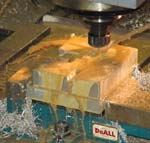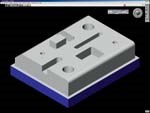Plugging Into STEP NC
CAM software companies are offering software programs that allow their users to read STEP-NC files into their existing CAM software to generate the tool path and output for specific CNC machines. These "plug-ins" make many of the benefits of STEP-NC available to the average machine shop today.
Share









Autodesk, Inc.
Featured Content
View More
The concept behind STEP NC is simple. It enables a product model database to serve as direct input to a CNC machine tool. No separate files of tool paths. No G or M codes. No post processors.
This is a radically different approach to CNC programming. It has far-reaching implications for the emerging possibilities of "e-manufacturing." Recent developments, however, promise to make it easier for CNC machine shops to make the transition to this technology. Without scrapping existing machine tool and CNC programming technology, shops now have a way to implement key aspects of STEP-NC.
Several leading CAM software companies have made it possible for STEP NC files to be used with their own software. This makes their users ready to participate in supply chains that are turning to global data exchange standards to streamline the flow of digital information over the Internet.
According to STEP Tools, Inc. (Troy, New York), a leading supplier of STEP software toolsets for application software developers, design firms and manufacturing companies, STEP NC offers significant savings to machine shops and their customers. The company estimates that, by fully implementing STEP NC, machine shops can reduce the time it takes to get jobs onto their machines by 35 percent if they can seamlessly read the 3D product geometry and manufacturing instructions of their customers. Likewise, original equipment manufacturers can reduce the time they spend preparing data for their suppliers by as much as 75 percent if they can seamlessly share the design and manufacturing data in their databases.
STEP Tools also estimates that STEP NC will reduce machining time for small- to mid-sized job lots by as much as 50 percent because STEP NC compliant CNC units will be capable of optimizing speeds and feeds with very little intervention from CNC programmers or machine operators. This factor could make it easier and safer to program high speed and five-axis machines, the company says, making it more likely that they will be used for small- to mid-sized job lots.
STEP NC In A Nutshell
STEP NC is an extension to STEP, the STandard for the Exchange of Product model data. STEP is the international standard that specifies a neutral data format for digital information about a product. STEP allows this data to be shared and exchanged among different and otherwise incompatible computer platforms. STEP NC standardizes how information about CNC machining can be added to parts represented in the STEP product model.
By using STEP NC to capture instructions on what steps to follow for machining the part, the "producability" of this part would not be affected by the availability a certain brand of control unit, programming system or post processor. Figure 1 compares the key features of STEP NC to current conventional approaches to creating CNC machine tool input.
If equipped with a STEP NC compliant CNC, any suitable machine tool could be designated to make the part. Because a product model database can be made accessible through the Internet, this designated machine tool could be linked to this global network virtually anywhere on earth. For manufacturing enterprises participating in a highly competitive global supply chain, this kind of flexibility is crucial. With the Internet acting as a global DNC system, the world becomes one big job shop.
Step Rather Than Leap
The availability of STEP NC software plug-ins for CAM software puts STEP NC within the reach of many shops. Currently, plug-ins are available for Gibbs CAM from Gibbs and Associates (Moorpark, California) and for Mastercam from CNC Software (Tolland, Connecticut). A plug-in for Esprit from DP Technology (Camarillo, California) will be completed soon. With these plug-ins (or "add-ins," as they are also called), a shop can take in a customer's STEP NC files and produce parts on existing CNC equipment.
A full implementation of STEP NC would involve equipping machine tools with CNCs customized with special software. This software enables the CNC to interpret the STEP-NC data directly and use the information to machine the part without a conventional G-code program. This software is currently under development.
Machine tools with PC-based open architecture control systems may be able to install this software to upgrade to STEP NC compatibility rather effectively. The conventional input/output (I/O) structure and the servo system of the CNC machine do not need to be modified under STEP NC.
Of course, a great many perfectly serviceable CNC machines are not candidates for STEP NC operation. Likewise, legacy data in the form of existing G-code part programs must be preserved. Shops are understandably reluctant to jeopardize these resources, even as they move toward STEP NC in future planning. The new plug-ins make it unnecessary to make a full leap to STEP NC. Essentially, a STEP NC plug-in provides a bridge between conventional CNC programming and the product-model-as-input approach of STEP NC.
A STEP NC plug-in converts a STEP NC file into the data structures of an existing CAM system. Once converted, the data can be used to generate tool paths the way the CAM software would process part geometry derived from a CAD file or other source.
The resulting output would also need to be postprocessed to produce machine-specific CNC code.
One key advantage to this approach is that the shop can promote its capability to accept STEP NC files. Knowing that the supply chain is populated with these manufacturing resources will encourage OEMs and large prime contractors to implement STEP NC. Ready access to job shops with STEP NC adds to the incentive for OEMs to adopt STEP NC as a means integrate machining instructions in the STEP product model database. As demand for STEP NC-enabled job shops grows, job shops will find it easier to justify the investment for full STEP NC implementation, which gains them all of the advantages of this streamlined approach to CNC operations.
The plug-in strategy reflects the wisdom of STEP NC developers and supporters. It tends to break the "you-first" syndrome that has stymied other standard-making initiatives. Creating momentum behind the implementation of STEP NC will speed the introduction of affordable STEP NC products to benefit both job shops and their customers.
Plug-In Demo
How a plug-in enables a conventional shop to use STEP NC files was demonstrated in February 2002, at the Industry Review Board meeting for the Model Driven Intelligent Control of Manufacturing (MDICM) project. The MDICM project, chartered to develop and deploy a digital input standard for CNC machines and awarded to STEP Tools, Inc. as the main contractor, is funded by the National Institute of Standards and Technology (NIST), an agency of the U.S. Commerce Department's Technology Administration. STEP NC is that digital exchange standard.
The Industrial Review Board—consisting of representatives from manufacturing companies, CAD/CAM software vendors, machine control builders, government and defense agencies and job shops (all stakeholders in the effort to streamline machining and manufacturing)—operates under the contract to help make sure the project truly meets its needs in a practical, realistic way.
The demonstration was held at Experimental Machine Tool & Plating Company in Troy, New York. This shop specializes in precision machining of complex workpieces in small lots, often on a prototype basis. With four CNC machining centers and four CNC lathes, it typifies the advanced job shop serving the aerospace and defense industry. The nearby Watervliet Arsenal is a frequent customer.
In the demonstration, the shop read a STEP NC-formatted file into its GibbsCAM programming system using the plug-in for this software. The plug-in converted the STEP NC information into GibbsCAM data structures and then used GibbsCAM to generate the necessary tool path and output machine specific code. The part, shown in the graphic above and to the right, was then machined in aluminum on the shop's Mori Seiki MV-65 machining center.
The demonstration also made use of GibbsCAM's Cut Part Rendering functionality to validate the machining process, and the Reporter functionality to generate corresponding process documentation. See Figure 2.
Because this is the final year of the 3-year ATP contract, demonstrations of STEP NC technology are vital to illustrate STEP NC's viability, raise general awareness of STEP NC and move STEP NC "from science fiction to within the horizon of realization," to borrow words from STEP Tools.
Clicking To STEP NC
A review of the online STEP NC resource can be seen at www.stepnc.com. STEP Tools is offering a downloadable version of its plug-in technology for GibbsCAM and Mastercam. The plug-ins are not initially available for production use. However, interested manufacturers can view and test-drive the technology as it is continuously improved in the coming years. The technology will benefit greatly from Phase One implementers who will use it to begin the process of integrating STEP-NC into their manufacturing programs and supply chain. This core group of companies will be breaking new ground in machining, and ultimately these advancements will be felt throughout the NC community.
Related Content
How this Job Shop Grew Capacity Without Expanding Footprint
This shop relies on digital solutions to grow their manufacturing business. With this approach, W.A. Pfeiffer has achieved seamless end-to-end connectivity, shorter lead times and increased throughput.
Read MoreHow to Mitigate Chatter to Boost Machining Rates
There are usually better solutions to chatter than just reducing the feed rate. Through vibration analysis, the chatter problem can be solved, enabling much higher metal removal rates, better quality and longer tool life.
Read MoreContinuous Improvement and New Functionality Are the Name of the Game
Mastercam 2025 incorporates big advancements and small — all based on customer feedback and the company’s commitment to keeping its signature product best in class.
Read MoreOrthopedic Event Discusses Manufacturing Strategies
At the seminar, representatives from multiple companies discussed strategies for making orthopedic devices accurately and efficiently.
Read MoreRead Next
Building Out a Foundation for Student Machinists
Autodesk and Haas have teamed up to produce an introductory course for students that covers the basics of CAD, CAM and CNC while providing them with a portfolio part.
Read More5 Rules of Thumb for Buying CNC Machine Tools
Use these tips to carefully plan your machine tool purchases and to avoid regretting your decision later.
Read MoreRegistration Now Open for the Precision Machining Technology Show (PMTS) 2025
The precision machining industry’s premier event returns to Cleveland, OH, April 1-3.
Read More











.png;maxWidth=150)



















.jpg;maxWidth=300;quality=90)













